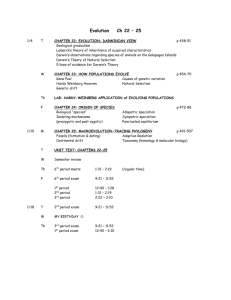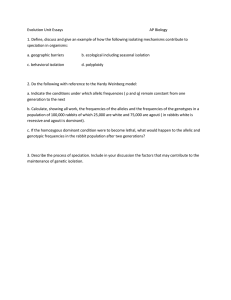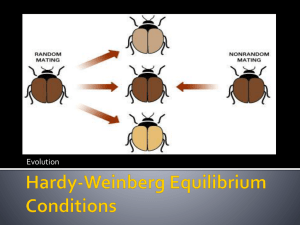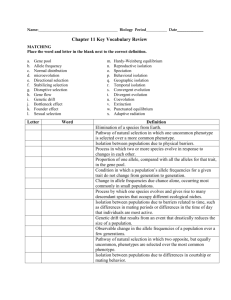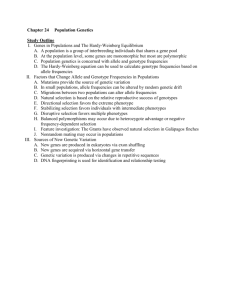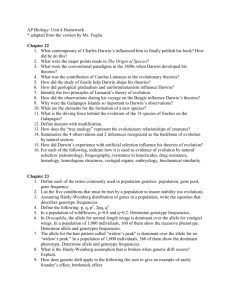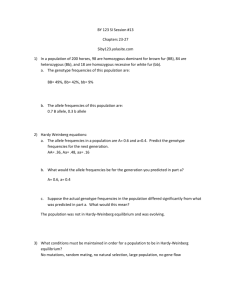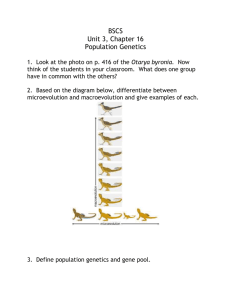Evolution Study Guide
advertisement
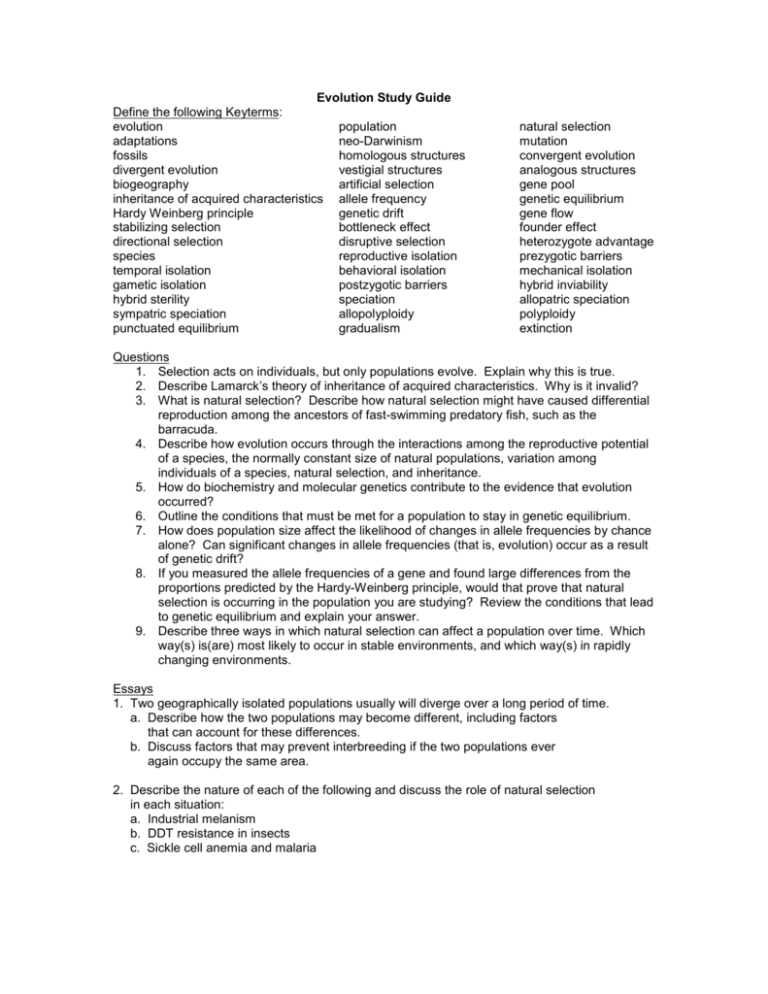
Evolution Study Guide Define the following Keyterms: evolution population adaptations neo-Darwinism fossils homologous structures divergent evolution vestigial structures biogeography artificial selection inheritance of acquired characteristics allele frequency Hardy Weinberg principle genetic drift stabilizing selection bottleneck effect directional selection disruptive selection species reproductive isolation temporal isolation behavioral isolation gametic isolation postzygotic barriers hybrid sterility speciation sympatric speciation allopolyploidy punctuated equilibrium gradualism natural selection mutation convergent evolution analogous structures gene pool genetic equilibrium gene flow founder effect heterozygote advantage prezygotic barriers mechanical isolation hybrid inviability allopatric speciation polyploidy extinction Questions 1. Selection acts on individuals, but only populations evolve. Explain why this is true. 2. Describe Lamarck’s theory of inheritance of acquired characteristics. Why is it invalid? 3. What is natural selection? Describe how natural selection might have caused differential reproduction among the ancestors of fast-swimming predatory fish, such as the barracuda. 4. Describe how evolution occurs through the interactions among the reproductive potential of a species, the normally constant size of natural populations, variation among individuals of a species, natural selection, and inheritance. 5. How do biochemistry and molecular genetics contribute to the evidence that evolution occurred? 6. Outline the conditions that must be met for a population to stay in genetic equilibrium. 7. How does population size affect the likelihood of changes in allele frequencies by chance alone? Can significant changes in allele frequencies (that is, evolution) occur as a result of genetic drift? 8. If you measured the allele frequencies of a gene and found large differences from the proportions predicted by the Hardy-Weinberg principle, would that prove that natural selection is occurring in the population you are studying? Review the conditions that lead to genetic equilibrium and explain your answer. 9. Describe three ways in which natural selection can affect a population over time. Which way(s) is(are) most likely to occur in stable environments, and which way(s) in rapidly changing environments. Essays 1. Two geographically isolated populations usually will diverge over a long period of time. a. Describe how the two populations may become different, including factors that can account for these differences. b. Discuss factors that may prevent interbreeding if the two populations ever again occupy the same area. 2. Describe the nature of each of the following and discuss the role of natural selection in each situation: a. Industrial melanism b. DDT resistance in insects c. Sickle cell anemia and malaria 3. Charles Darwin's theory of natural selection had a significant influence on the understanding of the evolution of organism. Discuss each of the following: a. the importance of Darwin's voyage on the H.M.S. Beagle to the development of his theory; b. the major points proposed by Darwin in his theory; c. two major refinements in Darwin's theory that stem from modern findings; 4. Define, discuss, and give an example of how each of the following isolating mechanisms contributes to speciation in organisms. a. Geographical barriers b. Ecological (including seasonal) isolation c. Behavioral isolation d. Polyploidy 5. Describe the modern theory of evolution and discuss how it is supported by evidence from two of the following three areas: a. Population genetics b. Molecular biology c. Comparative anatomy and embryology 6. Do the following with reference to the Hardy-Weinberg model. a. Indicate the conditions under which allele frequencies (p and Q) remain constant from one generation to the next. b. Calculate, showing all work, the frequencies of the alleles and frequencies of the genotypes in a population of 100,000 rabbits of which 25,000 are white and 75,000 are agouti. (In rabbits the white color is due to a recessive allele, w, and agouti is due to a dominant allele, W.) c. If the homozygous dominant condition were to become lethal, what would happen to the allelic and genotypic frequencies in the rabbit population after two generations? 7. Evolution is one of the unifying concepts of modern biology. Explain the mechanisms that lead to evolutionary change. Describe how scientists use each of the following as evidence for evolution: 1) Bacterial resistance to antibiotics 2) Comparative biochemistry 3) The fossil record 8. Genetic variation is the raw material for evolution. a. Explain three cellular and/or molecular mechanisms that introduce variation into the gene pool of a plant or animal population. b. Explain the evolutionary mechanisms that can change the composition of the gene pool.


